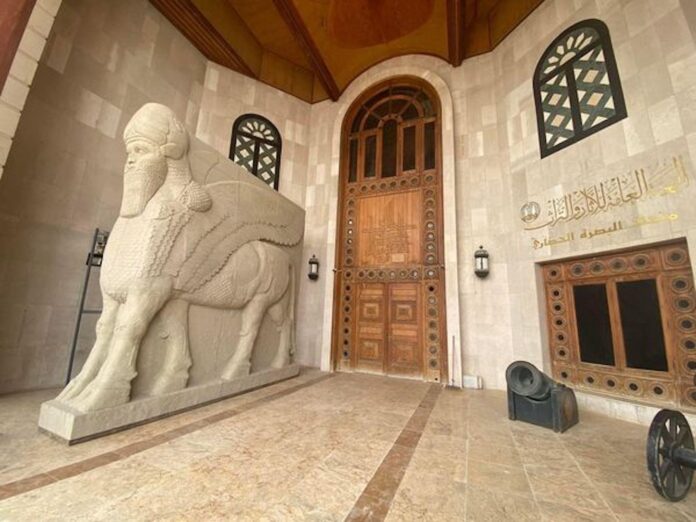Just in time for Iraq’s football victory at the Arabian Gulf Cup in Basra that drew thousands of fans to the Southern port town, the Basrah Museum has initiated a new project highlighting Iraqi cultural patrimony. Director Qahtan al Abeed has just launched the first part of a planned “Garden of Civilization” project in the courtyard of the museum.
Funded by the local governorate, a copy of the famous Lion of Babylon and the Assyrian Lamassu from the Iraqi Museum in Baghdad have been installed. Subject to further funding, plans are afoot for a copy of the Ziggurat of Ur and Babylon’s Ishtar gate to be installed in the garden.
“There are many Iraqis who can’t afford to visit their own heritage,” says Abeed. “This garden will allow them to ‘travel’ across Iraq and experience their country’s patrimony.”
Educational programmes for students are in the works and the project also aims to increase domestic and international cultural tourism.
The museum, currently housed in a refurbished former palace of Saddam Hussein, is itself a kind of shrine to contemporary Iraqi politics and society. The original museum, which closed in 1991, was one of nine museums looted by mobs during uprisings against the regime at the end of the First Gulf War. What remained of the collection was sent into storage in Baghdad.
The building itself—in the typical Basran Shanasheel style of the late Ottoman period, with intricate wooden lattice work—had once belonged to a Jewish date merchant until it was acquired by the Greek government and became its consulate from 1945 until 1971. In 1972, the Iraqi government, newly flush with revenue from oil nationalisation and a cultural and educational mandate, decided to turn it into a civic museum. The 1970s were the glory days of cultural infrastructure and investment in Iraq, with many theatres, galleries and educational institutions dating from that era.
The museum remained closed until 2003, at which point it was converted into a makeshift headquarters for the State Board of Heritage and Antiquities. Abeed, who studied archeology at the University of Baghdad and was a recent graduate at the time, hoped that the museum would re-open. Instead, it was soon occupied by squatters in the aftermath of the invasion. In 2005, when Mudhar Abd Alhay was director of the museum and Abeed his deputy, their car was shot up by squatters they were attempting to evict, killing Alhay.
Later, after Abeed became the director of the museum, he suggested to the Basra city council in 2008 that one of Saddam Hussein’s palaces, an ornate property on the Shatt al-Arab river built in 1990, might be the perfect spot for a new museum. With help from British army officer Hugo Clarke, John Curtis, then the keeper of the Middle East collections at the British Museum, Paul Collins, then curator for the Ancient Near East at the Ashmolean Museum in Oxford, and a group called Friends of Basrah Museum, the first gallery opened in 2016 and the grand opening happened in 2019.
Abeed says he was inspired by former director of the Iraq Museum in Baghdad, Sattaa Al-Hasri, who protected the land surrounding the museum when it was first allocated by building up the perimeter walls and gate.
“He created the Assyrian Gate to be the main entrance to the museum’s land,” Abeed says, “and ordered three copies of the Lion of Babylon to be made and put them in the remaining pillars to symbolically make borders of the museum’ ground.” Now, he says, after nearly 100 years, “we were able to make a professional copy of the Lion of Babylon that adorns the gate” of the Basrah Museum.
In addition to installing replicas of the Ziggurat of Ur and Babylon’s Ishtar gate, future plans, subject to funding, include a copy of the historic Al-Mokab Street in the city’s old town, all with the aim of “collecting the symbols of civilization in our precious Basra”.

























